Related Research Articles

The common cold or the cold is a viral infectious disease of the upper respiratory tract that primarily affects the respiratory mucosa of the nose, throat, sinuses, and larynx. Signs and symptoms may appear fewer than two days after exposure to the virus. These may include coughing, sore throat, runny nose, sneezing, headache, and fever. People usually recover in seven to ten days, but some symptoms may last up to three weeks. Occasionally, those with other health problems may develop pneumonia.

Tracheal intubation, usually simply referred to as intubation, is the placement of a flexible plastic tube into the trachea (windpipe) to maintain an open airway or to serve as a conduit through which to administer certain drugs. It is frequently performed in critically injured, ill, or anesthetized patients to facilitate ventilation of the lungs, including mechanical ventilation, and to prevent the possibility of asphyxiation or airway obstruction.

Mechanical ventilation or assisted ventilation is the medical term for using a machine called a ventilator to fully or partially provide artificial ventilation. Mechanical ventilation helps move air into and out of the lungs, with the main goal of helping the delivery of oxygen and removal of carbon dioxide. Mechanical ventilation is used for many reasons, including to protect the airway due to mechanical or neurologic cause, to ensure adequate oxygenation, or to remove excess carbon dioxide from the lungs. Various healthcare providers are involved with the use of mechanical ventilation and people who require ventilators are typically monitored in an intensive care unit.

Laryngoscopy is endoscopy of the larynx, a part of the throat. It is a medical procedure that is used to obtain a view, for example, of the vocal folds and the glottis. Laryngoscopy may be performed to facilitate tracheal intubation during general anaesthesia or cardiopulmonary resuscitation or for surgical procedures on the larynx or other parts of the upper tracheobronchial tree.

General anaesthesia (UK) or general anesthesia (US) is a method of medically inducing loss of consciousness that renders a patient unarousable even with painful stimuli. This effect is achieved by administering either intravenous or inhalational general anaesthetic medications, which often act in combination with an analgesic and neuromuscular blocking agent. Spontaneous ventilation is often inadequate during the procedure and intervention is often necessary to protect the airway. General anaesthesia is generally performed in an operating theater to allow surgical procedures that would otherwise be intolerably painful for a patient, or in an intensive care unit or emergency department to facilitate endotracheal intubation and mechanical ventilation in critically ill patients. Depending on the procedure, general anaesthesia may be optional or required. Regardless of whether a patient may prefer to be unconscious or not, certain pain stimuli could result in involuntary responses from the patient that may make an operation extremely difficult. Thus, for many procedures, general anaesthesia is required from a practical perspective.

Respiratory syncytial virus (RSV), also called human respiratory syncytial virus (hRSV) and human orthopneumovirus, is a contagious virus that causes infections of the respiratory tract. It is a negative-sense, single-stranded RNA virus. Its name is derived from the large cells known as syncytia that form when infected cells fuse.

Airway management includes a set of maneuvers and medical procedures performed to prevent and relieve airway obstruction. This ensures an open pathway for gas exchange between a patient's lungs and the atmosphere. This is accomplished by either clearing a previously obstructed airway; or by preventing airway obstruction in cases such as anaphylaxis, the obtunded patient, or medical sedation. Airway obstruction can be caused by the tongue, foreign objects, the tissues of the airway itself, and bodily fluids such as blood and gastric contents (aspiration).
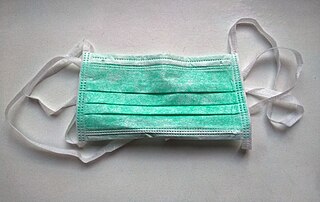
A surgical mask, also known by other names such as a medical face mask or procedure mask, is a personal protective equipment used by healthcare professionals that serves as a mechanical barrier that interferes with direct airflow in and out of respiratory orifices. This helps reduce airborne transmission of pathogens and other aerosolized contaminants between the wearer and nearby people via respiratory droplets ejected when sneezing, coughing, forceful expiration or unintentionally spitting when talking, etc. Surgical masks may be labeled as surgical, isolation, dental or medical procedure masks.

Non-invasive ventilation (NIV) is the use of breathing support administered through a face mask, nasal mask, or a helmet. Air, usually with added oxygen, is given through the mask under positive pressure; generally the amount of pressure is alternated depending on whether someone is breathing in or out. It is termed "non-invasive" because it is delivered with a mask that is tightly fitted to the face or around the head, but without a need for tracheal intubation. While there are similarities with regard to the interface, NIV is not the same as continuous positive airway pressure (CPAP), which applies a single level of positive airway pressure throughout the whole respiratory cycle; CPAP does not deliver ventilation but is occasionally used in conditions also treated with NIV.
Ventilator-associated pneumonia (VAP) is a type of lung infection that occurs in people who are on mechanical ventilation breathing machines in hospitals. As such, VAP typically affects critically ill persons that are in an intensive care unit (ICU) and have been on a mechanical ventilator for at least 48 hours. VAP is a major source of increased illness and death. Persons with VAP have increased lengths of ICU hospitalization and have up to a 20–30% death rate. The diagnosis of VAP varies among hospitals and providers but usually requires a new infiltrate on chest x-ray plus two or more other factors. These factors include temperatures of >38 °C or <36 °C, a white blood cell count of >12 × 109/ml, purulent secretions from the airways in the lung, and/or reduction in gas exchange.

Airborne transmission or aerosol transmission is transmission of an infectious disease through small particles suspended in the air. Infectious diseases capable of airborne transmission include many of considerable importance both in human and veterinary medicine. The relevant infectious agent may be viruses, bacteria, or fungi, and they may be spread through breathing, talking, coughing, sneezing, raising of dust, spraying of liquids, flushing toilets, or any activities which generate aerosol particles or droplets.

Heated humidified high-flow therapy, often simply called high flow therapy, is a type of respiratory support that delivers a flow of medical gas to a patient of up to 60 liters per minute and 100% oxygen through a large bore or high flow nasal cannula. Primarily studied in neonates, it has also been found effective in some adults to treat hypoxemia and work of breathing issues. The key components of it are a gas blender, heated humidifier, heated circuit, and cannula.
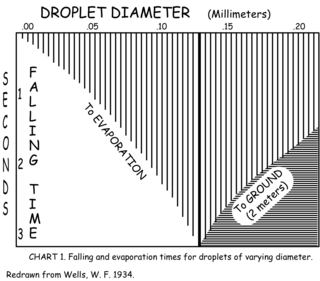
The Wells curve is a diagram, developed by W. F. Wells in 1934, which describes what is expected to happen to small droplets once they have been exhaled into air. Coughing, sneezing, and other violent exhalations produce high numbers of respiratory droplets derived from saliva and/or respiratory mucus, with sizes ranging from about 1 µm to 2 mm. Wells' insight was that such droplets would have two distinct fates, depending on their sizes. The interplay of gravity and evaporation means that droplets larger than a humidity-determined threshold size would fall to the ground due to gravity, while droplets smaller than this size would quickly evaporate, leaving a dry residue that drifts in the air. Since droplets from an infected person may contain infectious bacteria or viruses, these processes influence transmission of respiratory diseases.
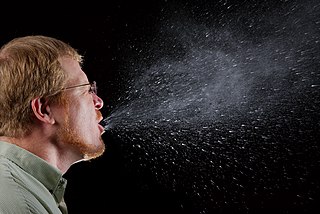
A respiratory droplet is a small aqueous droplet produced by exhalation, consisting of saliva or mucus and other matter derived from respiratory tract surfaces. Respiratory droplets are produced naturally as a result of breathing, speaking, sneezing, coughing, or vomiting, so they are always present in our breath, but speaking and coughing increase their number.
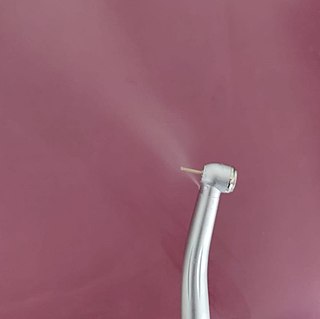
A dental aerosol is an aerosol that is produced from dental instrument, dental handpieces, three-way syringes, and other high-speed instruments. These aerosols may remain suspended in the clinical environment. Dental aerosols can pose risks to the clinician, staff, and other patients. The heavier particles contained within the aerosols are likely to remain suspended in the air for relatively short period and settle quickly onto surfaces, however, the lighter particles may remain suspended for longer periods and may travel some distance from the source. These smaller particles are capable of becoming deposited in the lungs when inhaled and provide a route of diseases transmission. Different dental instruments produce varying quantities of aerosol, and therefore are likely to pose differing risks of dispersing microbes from the mouth. Air turbine dental handpieces generally produce more aerosol, with electric micromotor handpieces producing less, although this depends on the configuration of water coolant used by the handpiece.

Hazard controls for COVID-19 in workplaces are the application of occupational safety and health methodologies for hazard controls to the prevention of COVID-19. Vaccination is the most effective way to protect against severe illness or death from COVID-19. Multiple layers of controls are recommended, including measures such as remote work and flextime, increased ventilation, personal protective equipment (PPE) and face coverings, social distancing, and enhanced cleaning programs.
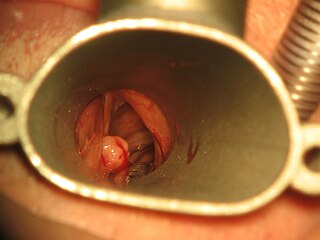
Intubation granuloma is a benign growth of granulation tissue in the larynx or trachea, which arises from tissue trauma due to endotracheal intubation. This medical condition is described as a common late complication of tracheal intubation, specifically caused by irritation to the mucosal tissue of the airway during insertion or removal of the patient's intubation tube.

Source control is a strategy for reducing disease transmission by blocking respiratory secretions produced through speaking, coughing, sneezing or singing. Surgical masks are commonly used for this purpose, with cloth face masks recommended for use by the public only in epidemic situations when there are shortages of surgical masks. In addition, respiratory etiquette such as covering the mouth and nose with a tissue when coughing can be considered source control. In diseases transmitted by droplets or aerosols, understanding air flow, particle and aerosol transport may lead to rational infrastructural source control measures that minimize exposure of susceptible persons.
William Firth Wells was an American scientist and sanitary engineer. In his early career, he pioneered techniques for the aquaculture of oysters and clams. He is best known for his work on airborne infections. Wells identified that tuberculosis could be transmitted through air via the nuclei of evaporated respiratory droplets, and developed the Wells curve to describe what happens to respiratory droplets after they have been expelled into the air.
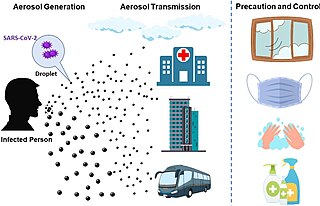
The transmission of COVID-19 is the passing of coronavirus disease 2019 from person to person. COVID-19 is mainly transmitted when people breathe in air contaminated by droplets/aerosols and small airborne particles containing the virus. Infected people exhale those particles as they breathe, talk, cough, sneeze, or sing. Transmission is more likely the closer people are. However, infection can occur over longer distances, particularly indoors.
References
- 1 2 3 Klompas, Michael; Baker, Meghan; Rhee, Chanu (2021-02-01). "What Is an Aerosol-Generating Procedure?". JAMA Surgery. 156 (2): 113–114. doi: 10.1001/jamasurg.2020.6643 . ISSN 2168-6254. PMID 33320188.
- ↑ Zayas, Gustavo; Chiang, Ming; Wong, Eric; MacDonald, Fred; F Lange, Carlos; Senthilselvan, Ambikaipakan; King, Malcolm (21 March 2012). ""Cough aerosol in healthy participants: fundamental knowledge to optimize droplet-spread infectious respiratory disease management"". BMC Pulmonary Medicine. 12. doi: 10.1186/1471-2466-12-11 . PMID 22436202.
Small size droplets (< 1 μm) predominated the total number of droplets expelled when coughing
- ↑ Stadnytskyi, Valentyn; Bax, Christina E.; Bax, Adriaan; Anfinrud, Philip (May 13, 2020). ""The airborne lifetime of small speech droplets and their potential importance in SARS-CoV-2 transmission"". Proceedings of the National Academy of Sciences. 117 (22): 11875–11877. Bibcode:2020PNAS..11711875S. doi: 10.1073/pnas.2006874117 . PMC 7275719 . PMID 32404416.
These observations confirm that there is a substantial probability that normal speaking causes airborne virus transmission in confined environments.
- ↑ Bourouiba, Lydia (October 6, 2020). "The Fluid Dynamics of Disease Transmission". Annual Review of Fluid Mechanics. 53: 473–508. doi:10.1146/annurev-fluid-060220-113712 . Retrieved 21 March 2024.
- ↑ Wang, Chia C.; Prather, Kimberly A; Sznitman, Josué; Jimenez, Jose L; Lakdawala, Seema S.; Tufekci, Zeynep; Marr, Linsey C. (27 Aug 2021). "Airborne transmission of respiratory viruses". Science. 373 (6558). doi:10.1126/science.abd9149. PMC 8721651 . PMID 34446582.
Given the lack of evidence for droplet and fomite transmission and the increasingly strong evidence for aerosols in transmitting numerous respiratory viruses, we must acknowledge that airborne transmission is much more prevalent than previously recognized.
- ↑ MacIntyre, C Raina; Veness, Benjamin; Ananda-Rajah, Michelle (June 16, 2021). ""At last, health, aged care and quarantine workers get the right masks to protect against airborne coronavirus"". The_Conversation_(website) . Retrieved 21 March 2024.
The existing guidelines said health providers working around COVID-19 patients should wear a surgical mask. It restricted use of the more protective P2 or N95 masks, which stop airborne particles getting through, to very limited scenarios. These involved "aerosol-generating procedures", such as inserting a breathing tube.
- ↑ El-Boghdadly, K.; Wong, D. J. N.; Owen, R.; Neuman, M. D.; Pocock, S.; Carlisle, J. B.; Johnstone, C.; Andruszkiewicz, P.; Baker, P. A.; Biccard, B. M.; Bryson, G. L. (2020-06-09). "Risks to healthcare workers following tracheal intubation of patients with COVID-19: a prospective international multicentre cohort study". Anaesthesia. 75 (11): 1437–1447. doi: 10.1111/anae.15170 . ISSN 1365-2044. PMC 7300828 . PMID 32516833.
- ↑ Tran K, Cimon K, Severn M, Pessoa-Silva CL, Conly J (April 2012). "Aerosol generating procedures and risk of transmission of acute respiratory infections to healthcare workers: a systematic review". PLOS ONE. 7 (4): e35797. Bibcode:2012PLoSO...735797T. doi: 10.1371/journal.pone.0035797 . PMC 3338532 . PMID 22563403.
- ↑ Wilson, Nick; Corbett, Stephen; Tovey, Euan (2020). "Airborne transmission of covid-19". BMJ. BMJ 2020;370:m3206. 370: m3206. doi: 10.1136/bmj.m3206 . PMID 32819961. S2CID 221178291. Archived from the original on 2020-08-21.
- 1 2 Brown, J.; Gregson, F. K. A.; Shrimpton, A.; Cook, T. M.; Bzdek, B. R.; Reid, J. P.; Pickering, A. E. (2021). "A quantitative evaluation of aerosol generation during tracheal intubation and extubation". Anaesthesia. 76 (2): 174–181. doi: 10.1111/anae.15292 . ISSN 0003-2409. PMC 7675579 . PMID 33022093.
- 1 2 Dhillon, R. S.; Rowin, W. A.; Humphries, R. S.; Kevin, K.; Ward, J. D.; Phan, T. D.; Nguyen, L. V.; Wynne, D. D.; Scott, D. A.; the Clinical Aerosolisation Study Group; Yule, A. (2021). "Aerosolisation during tracheal intubation and extubation in an operating theatre setting". Anaesthesia. 76 (2): 182–188. doi:10.1111/anae.15301. ISSN 0003-2409. PMC 7675280 . PMID 33047327.
- 1 2 Shrimpton, A. J.; Brown, J. M.; Gregson, F. K. A.; Cook, T. M.; Scott, D. A.; McGain, F.; Humphries, R. S.; Dhillon, R. S.; Bzdek, B. R.; Hamilton, F.; Reid, J. P. (2021-08-26). "A quantitative evaluation of aerosol generation during manual facemask ventilation". medRxiv 10.1101/2021.08.23.21262441v1 .
- ↑ Phillips, Frank; Crowley, Jane; Warburton, Samantha; Gordon, George S.D.; Parra-Blanco, Adolfo (June 2022). "Aerosol and droplet generation in upper and lower gastrointestinal endoscopy: whole procedure and event-based analysis". Gastrointestinal Endoscopy. 96 (4): 603–611.e0. doi: 10.1016/j.gie.2022.05.018 . PMC 9386278 . PMID 35659608. S2CID 249324970.
- ↑ Nestor, C. C.; Wang, S.; Irwin, M. G. (2021). "Are tracheal intubation and extubation aerosol-generating procedures?". Anaesthesia. 76 (2): 151–155. doi:10.1111/anae.15328. ISSN 0003-2409. PMC 7753480 . PMID 33274761.
- ↑ Thuresson, Sara (2022). "Airborne SARS-CoV-2 in hospitals – effects of aerosol-generating procedures, HEPA-filtration units, patient viral load and physical distance". Clinical Infectious Diseases. 75 (1): e89–e96. doi: 10.1093/cid/ciac161 . PMC 9383519 . PMID 35226740.
- ↑ Coleman, Kristen K; Wen Tay, Douglas Jie; Sen Tan, Kai; Xiang Ong, Sean Wei; Than, The Son; Koh, Ming Hui; Chin, Yi Qing; Nasir, Haziq; Mak, Tze Minn; Jang Hann Chu, Justin; Milton, Donald K; Chow, Vincent T K; Tambyah, Paul Anantharajah; Chen, Mark; Tham, Kwok Wai (15 May 2022). "Viral Load of Severe Acute Respiratory Syndrome Coronavirus 2 (SARS-CoV-2) in Respiratory Aerosols Emitted by Patients With Coronavirus Disease 2019 (COVID-19) While Breathing, Talking, and Singing". Clinical Infectious Diseases. 74 (10): 1722–1728. doi:10.1093/cid/ciab691. PMC 8436389 . PMID 34358292 . Retrieved March 20, 2024.